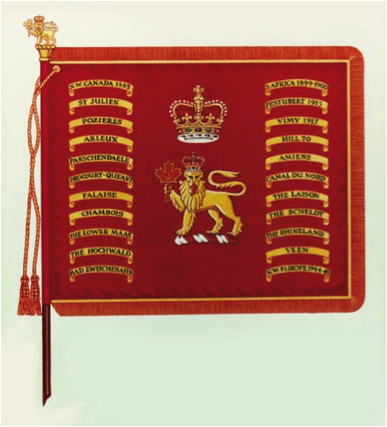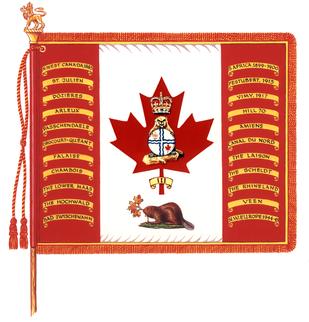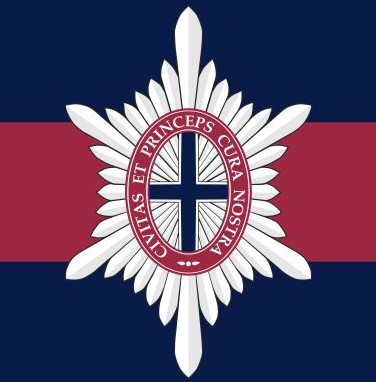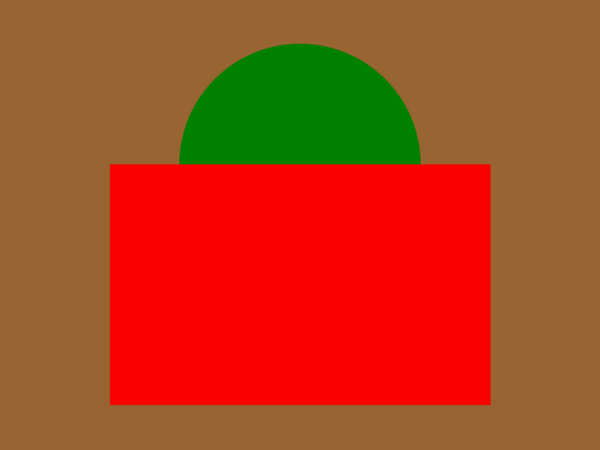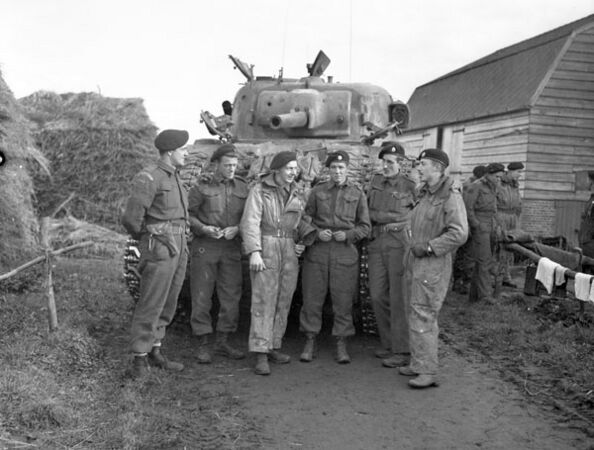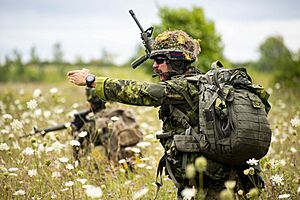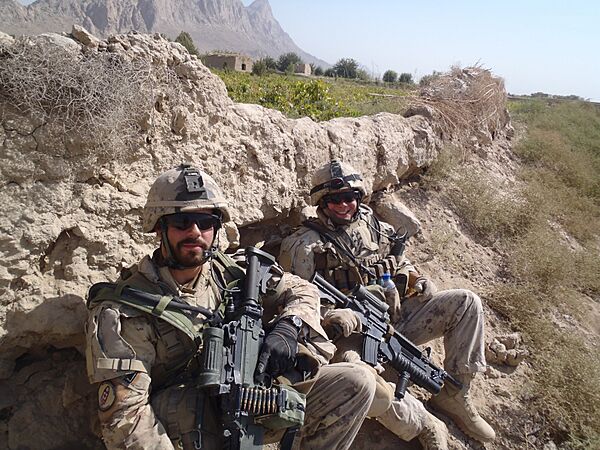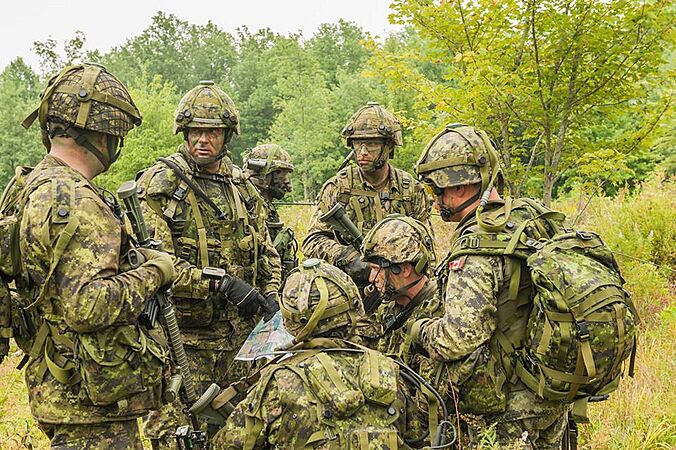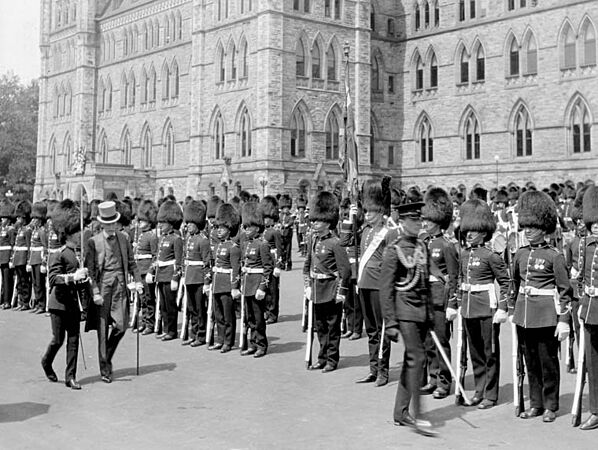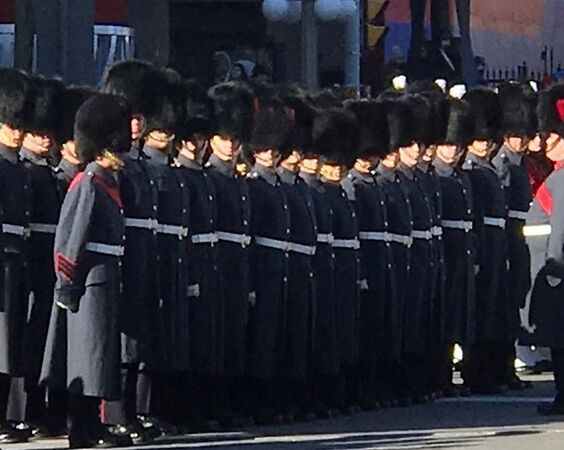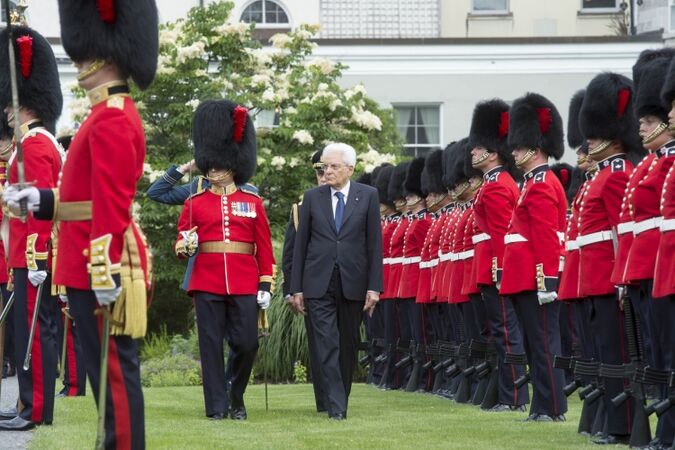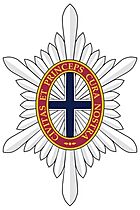Governor General's Foot Guards facts for kids
Quick facts for kids Governor General's Foot Guards |
|
|---|---|
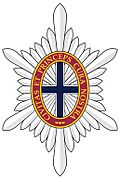
|
|
| Active | 1872–present |
| Country | Canada |
| Branch | Canadian Army |
| Type | Foot guards |
| Role | Light infantry |
| Size | Battalion |
| Part of | 33 Canadian Brigade Group |
| Garrison/HQ | Cartier Square Drill Hall Ottawa, Ontario |
| Nickname(s) |
|
| Motto(s) |
|
| March |
|
| Anniversaries |
|
| Engagements |
|
| Battle honours | See list |
| Commanders | |
| Colonel of the Regiment |
Mary Simon (ex officio as Governor General) |
| Lieutenant Colonel Commanding | LCol Jamie Bell |
| Regimental Sergeant Major | CWO Stephane Marleau |
| Insignia | |
| Headdress | Khaki beret |
The Governor General's Foot Guards (GGFG) is an important army unit in Canada. It's a special group of soldiers who train part-time. They are based in Ottawa, Canada's capital city, at the Cartier Square Drill Hall.
GGFG soldiers are part-time, but they also train full-time for special tasks. These tasks include helping during natural disasters or emergencies in Canada. For example, they helped during the 1998 Ice Storm, floods in 2017 and 2019, and the COVID-19 pandemic in 2020. They also train for missions in other countries, supporting Canada's main army. In recent years, GGFG troops have served in places like Afghanistan, Sudan, Iraq, Jordan, Egypt, Latvia, and Ukraine.
Members of the GGFG usually train on Tuesday evenings and one weekend a month from September to June. From May to August, they can work full-time. This includes being students or teachers on training courses, taking part in the Ceremonial Guard, and joining field exercises.
The GGFG also has special training programs. These include marksmanship to improve shooting skills and leadership training to help soldiers become leaders. They also have sports and fitness programs. The GGFG works closely with the 1st Battalion, The Royal Canadian Regiment (1 RCR), for training.
The GGFG keeps alive the history of two important units from the First World War: the 2nd Canadian Battalion (Eastern Ontario Regiment), CEF and the 77th Battalion (Ottawa), CEF.
Contents
How the GGFG Is Organized
The GGFG is made up of several smaller groups:
- Regimental Headquarters: This group is in charge of leading and managing all the soldiers in the regiment.
- No. 1 Company (Rifle Company): This company practices field training exercises. They learn to work together as a team in different battle situations. Most trained soldiers are in this company.
- No. 2 Company (Training Company): This company runs courses for soldiers to get new skills or special training. It has teachers and students. New soldiers join this company until they are fully trained.
- No. 3 Company (Combat Service Support): This company helps the other companies with supplies and support during training.
- GGFG Band: This is a music band that plays for the regiment at events in the city and beyond.
- Public Duties Company: This company plans and performs the Ceremonial Guard duties in the summer. They also help the Governor General with special events all year.
The regiment also supports the 2784 GGFG Army Cadets. This is a youth program for young people interested in the military.
Since 2020, the Public Duties Company has been the official guard of honour for the Canadian Armed Forces. This happened because the regular Ceremonial Guard activities were paused due to the COVID-19 pandemic.
History of the GGFG
The GGFG started in Ottawa, Ontario, on June 7, 1872. It was first called the 1st Battalion Governor General's Foot Guards. Over the years, its name changed a few times. It returned to being called the Governor General's Foot Guards on September 1, 1976.
In the Canadian Forces, units can form special connections called affiliations. These links help military groups stay connected. The GGFG was once linked with the Canadian Guards. From 1954 to 1976, they even used a Canadian Guards battalion number. However, the GGFG was always a separate regiment. This link ended in 1970 when the Canadian Guards unit was put on hold.
What the GGFG Has Done
GGFG soldiers took part in the Nile Expedition in 1884. The next year, they sent a group of sharpshooters to the North-West Rebellion. During this time, the regiment had its first two soldiers killed in action at the Battle of Cut Knife Hill.
During the Second Boer War, many GGFG volunteers joined other Canadian groups. Most of them served with the 2nd (Special Service) Battalion, Royal Canadian Regiment of Infantry.
GGFG in the First World War
The GGFG carries on the traditions of two battalions that fought in the First World War.
The 2nd Battalion (Eastern Ontario Regiment), CEF, also known as "The Iron Second," fought continuously on the Western Front from 1915 to 1918. This battalion fought in many famous battles, including Ypres, St. Julien, Vimy (1917), and Passchendaele. By the end of the war, 242 officers and 5,084 other soldiers had served with this battalion. Sadly, 52 officers and 1,227 other soldiers were killed.
The 77th Battalion (Ottawa), CEF was formed on July 10, 1915. It went to Great Britain in June 1916. This battalion sent new soldiers to help the Canadian Corps. In September 1916, its soldiers joined other battalions, and the 77th Battalion was then closed.
The GGFG proudly continues the history and traditions of these brave battalions.
GGFG in the Second World War
During the Second World War, the GGFG was called into action in May 1940. In 1942, the regiment changed its role to become an armoured unit, meaning they used tanks. They were renamed the "21st Canadian Armoured Regiment (GGFG)." They went to Great Britain in September 1942.
On July 24, 1944, they landed in France as part of the 4th Canadian Armoured Brigade. They fought in northwest Europe until the war ended. They took part in important battles like the Battle of Normandy, the Battle of the Scheldt, and the Rhineland. During the war, 101 soldiers from the regiment were killed, and 284 were wounded. This overseas regiment was officially closed on January 31, 1946.
GGFG Today
In recent years, GGFG members have taken part in missions with the United Nations and NATO. This includes serving in places like Cyprus, Somalia, the former Yugoslavia, Haiti, Ethiopia, and Sierra Leone.
During Canada's mission in Afghanistan, GGFG members were deployed to Kandahar and Kabul. The GGFG also sends individual soldiers to support the main army when they go on missions. They have sent members to Operation Impact in Iraq and Jordan, Operation Calumet in Egypt, Operation Soprano in Sudan, Operation Reassurance in Poland and Latvia, and Operation Unifier in Ukraine.
The regiment is also ready to help Canadians at home during natural disasters or emergencies. GGFG soldiers helped during the 1998 Ice Storm, floods in 2017 and 2019, and the COVID-19 pandemic in 2020.
Brave Soldiers: Victoria Cross Winners
The Victoria Cross is the highest award for bravery in the British and Commonwealth armed forces. Two soldiers from units linked to the GGFG received this award:
- Leo Clarke: He was an Acting Corporal in the 2nd Battalion, Canadian Expeditionary Force. He earned his Victoria Cross at Pozières, France, on September 9, 1916.
- Okill Massey Learmonth: He was an Acting Major in the 2nd Battalion, Canadian Expeditionary Force. He received his Victoria Cross at Hill 70, France, on August 18, 1917.
Special Memorials
There are several memorials dedicated to the GGFG:
- A memorial tablet was put up on May 2, 1887. It remembers Privates J. Rogers and Wm. B. Osgood, who died at Cut Knife Hill during the Northwest Rebellion.
- A plaque in the GGFG Regimental Museum honors the 5326 officers and men who served in the 2nd Canadian Infantry Battalion during the First World War.
- A Sherman tank called Forceful III at the Canadian War Museum is dedicated to GGFG members killed in the Second World War.
Alliances
The GGFG has a special connection with the Coldstream Guards in the United Kingdom.
Battle Honours
Battle honours are special awards given to military units for their bravery and service in battles. The GGFG has received many battle honours, including for:
- North West Canada, 1885
- South Africa 1899–1900
- First World War: Ypres 1915, Flers-Courcelette, Passchendaele, Vimy 1917, Somme, Hill 70, and many more battles in France and Flanders.
- Second World War: The Hochwald, The Rhineland, Falaise, The Scheldt, and other battles in Northwest Europe.
- Afghanistan
Special Rank Names
Some ranks in the GGFG have special names:
- Ensign: Second lieutenants (new officers) are called Ensigns. This name comes from their old job of carrying the unit's flag or "ensign."
- Colour Sergeant: Warrant officers are called Colour Sergeants. This rank started because these sergeants were chosen to protect the unit's flags.
- Guardsman: After basic training, soldiers are called Guardsmen. King George V gave this special honor in 1918 to recognize the Foot Guards' service in the First World War.
- Musician: Members of the band are called Musicians after they finish their training.
-
Viscount Willingdon inspecting the GGFG in 1927.
-
The President of Italy Sergio Mattarella inspecting an honour guard of the GGFG during his visit to Rideau Hall.
GGFG Museum
| Location | Cartier Square Drill Hall Ottawa, Ontario |
|---|---|
| Type | Regimental museum |
The Governor General's Foot Guards Regimental Museum collects and displays items that show the history and traditions of the regiment. The museum gathers materials about the regiment's past, including its role in wars, ceremonies, training, and sports. It works to keep these items safe and available for everyone to see and learn from.
The museum is a non-profit place for education. It is open to the public and works with other museums, like the National War Museum, to preserve important historical items. The museum has many artifacts from the regiment's history. Some items on display include a captured German trench periscope, old firearms like a Second World War German MG42 and an MP 40, and a copy of Mein Kampf signed by Adolf Hitler. There are also books with photos from World War II. The museum is located in the south end of the Cartier Square Drill Hall. You can visit it on parade nights or by making an appointment.
Freedom of the City
The regiment has been given the "Freedom of the City" honor twice by the city of Ottawa:
- 1972
- 2022
Regimental Badge and Motto
|
See also
- Canadian Guards
- Military history of Canada
- History of the Canadian Army
- Governor General's Foot Guards Band
- Ceremonial Guard



